Hans Marsilius Purrmann is born on April 10, 1880 in Speyer, Kleine Greifengasse 14, as the first son of the painter Georg Heinrich Purrmann (1846–1900) and his wife Elisabeth, née Schirmer (1848–1916). He has a younger brother, Heinrich Christian (1881–1943), who married Elisabeth von Walck, and a younger sister, Friederike (1884–1963), who married the postal inspector Otto Albig in 1913. Purrmann remained steadily in contact with both his siblings throughout their lives; large parts of their correspondence are extant.
Biography
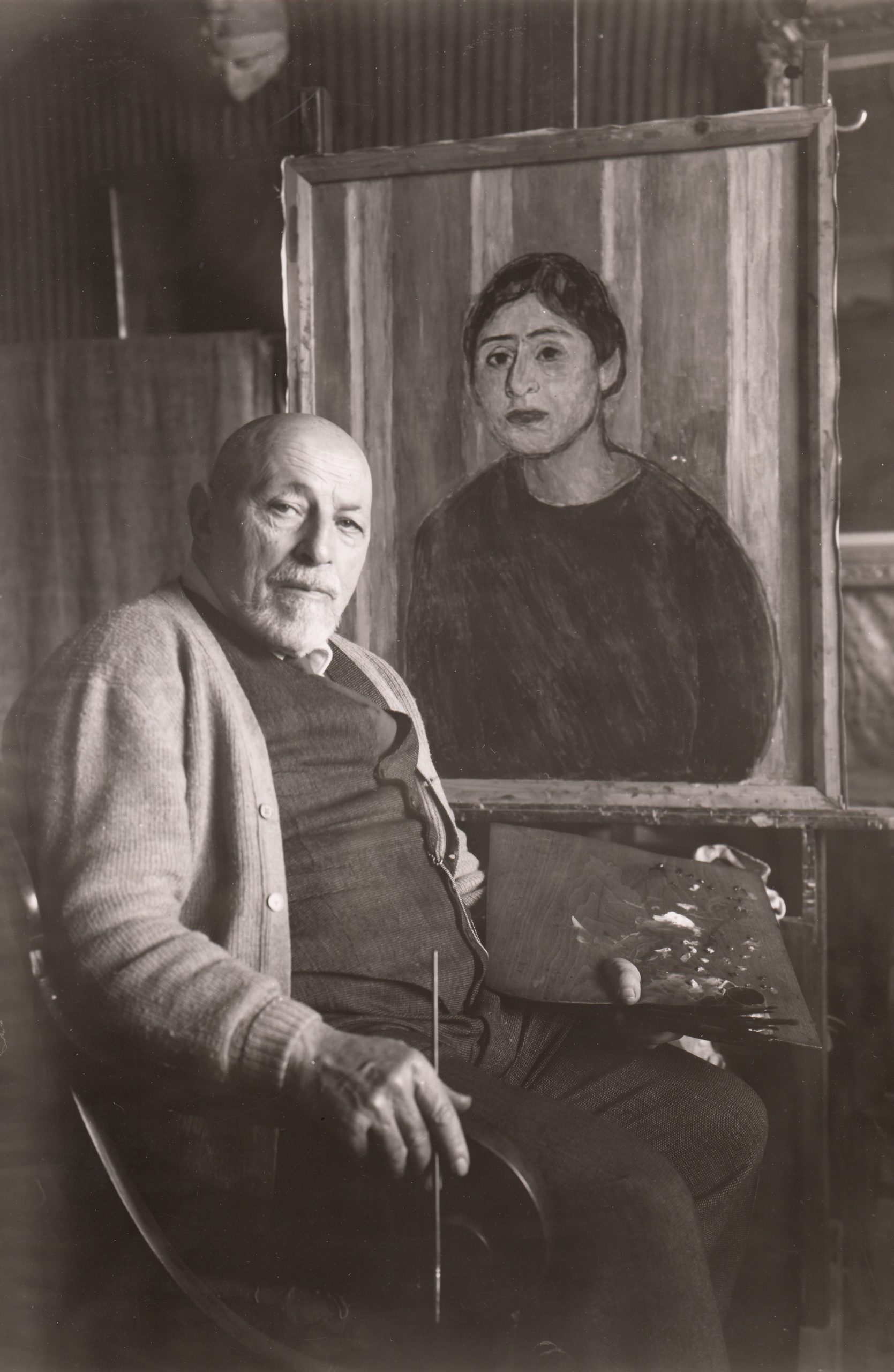
“As a painter he gained strong influence, because his oeuvre that had been strongly influenced by Matisse became a lesson to the colourism which had been neglected in Germany, and because he had elaborated his judgment of art with a rare deeper insight. He was a thinking artist, but he did not think conceptionally, but using his senses. What made his person and his words impressive was his learned skill to reduce art to the basics. Without having a teacher personality, everything he did and said was didactic. Even when he failed, his failure was still instructional and full of character.
He had learned the trade of a decorative painter at his father’s business in the Palatinate, had been Stuck’s pupil in Munich and had learned the key issue in Paris. … In Germany he was an unusual phenomenon because he thought strictly in terms of form and was unconcerned with content, world view and substance; yet he took the concept of form broadly and deeply enough to encompass all life. His appearance had something insistent about it, due to the intensity of its expression. His head attracted attention everywhere, without knowing him one could say about Purrmann only this: this man can only think essentially. Nobody else was so lucky in browsing antique shops, he always found a rare or unknown valuable object. Of course he deserved the luck. Only like a few other people, he had perceived the whole art culture of that time and time before and could understand the artists’ souls of all times.”
(Karl Scheffler, “Die fetten und die mageren Jahre”, Leipzig/Munich 1946, p. 213 f.)
Speyer | Munich | Berlin 1880-1904
1880
1886-1893
Purrmann’s school years are brief; he attends primary school in Speyer, followed by one year of secondary school there. “In knowledge and school training, I could have been outdone by any maid. Only with difficulty, as a “weak”... pupil, did I make it through part of primary school and a single year of secondary school.” (Purrmann 1951, in Göpel 1961, p. 11)
1893-1895
Purrmann learns the trade of decorative painting from his father. On the side, he pursues artistic interests of his own, as can be seen in the small townscapes and a larger landscape painted in the environs of Speyer.
1895-1897
Interior decorator in his father's business
1897
Purrmann registers as a resident with the Munich police on October 24. He begins his studies at the Academy of Visual Arts in Munich in the winter semester of that year. Purrmann first studies drawing under Gabriel von Hackl, then painting with Franz von Stuck. Among his fellow students are Paul Klee, Wassily Kandinsky, Albert Weisgerber, Eugen von Kahler, and Willi Geiger.
1899
Purrmann’s father’s poor health prevents him from going to Munich in 1899.
1900
Purrmann’s father Georg dies on July 5. His brother Heinrich takes over the family business, providing Purrmann with the opportunity to become an independent artist.
1902-1903
Purrmann receives the Henry Hilgard Grant for the Advancement of Visual Artists in the Palatinate in both these years (Jöckle 2001, p. 268).
1903-1904
Purrmann is twice a guest during the summer months in Svinar, near Prague, at the family residence of Eugen von Kahler (1882–1911). Purrmann makes a number of paintings of parks and gardens, and a photo shows the two artists in 1903 in front of one of Purrmann’s paintings.
1903-1905
During these years, Purrmann was able to take part in the spring exhibitions of the Munich Secession thanks to the intercession of Franz von Stuck, for which he received favourable reviews from Wilhelm Wittmann and Hans Rosenhagen. According to Karl Scheffler, Purrmann was discovered by the art historian Karl Voll, who taught in Munich. Voll's students Friedrich Rintelen and Heinz Braune also soon became acquainted with Purrmann. Together with them and his painting students Albert Weisgerber, Eugen von Kahler and Gino de Finetti, among others, he was a regular at Café Stefanie, a famous meeting place for Munich's bohemian artists.
1904-1905
In November 1904, Purrmann moved to Berlin, where he stayed until spring 1905. He initially stayed with fellow Munich student Gino de Finetti and also socialised regularly with Friedrich Rintelen. He took drawing lessons from Lovis Corinth at the Lewin-Funcke School, studied the Old Masters in museums and became enthusiastic about French and German Impressionist painting.
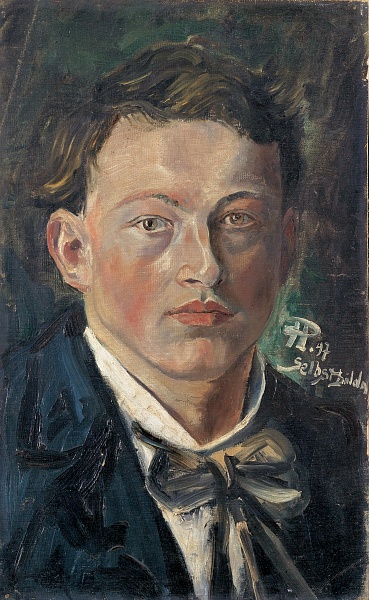
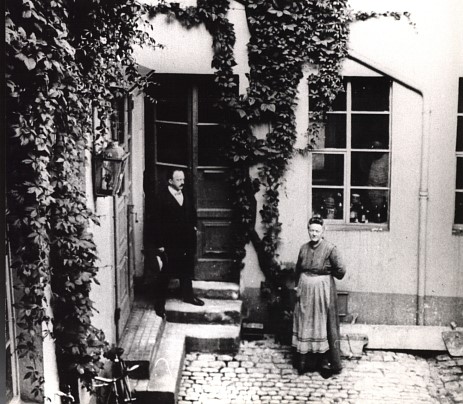
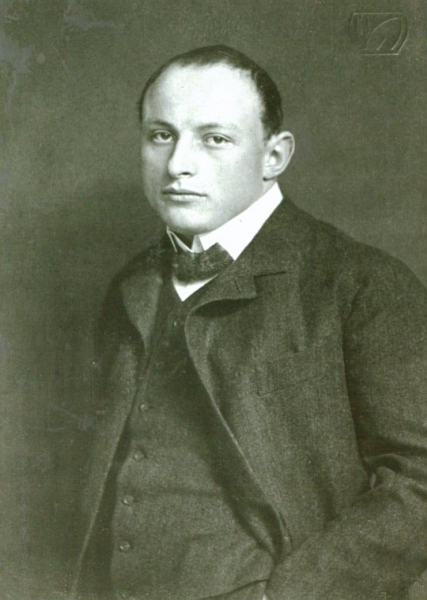
Paris 1905-1914
1905
One of the main attractions of 1905 is the Manet exhibition at the Paris Autumn Salon. Purrmann goes to the Autumn Salon and views works by the “Fauves,” in particular Matisse and Derain. In November, he moves to Paris, spending his time, in the period before he had learned French, in the circle of German-speaking painters at the Café du Dôme. He is welcomed by Rudolf Levy, Walter Bondy, and Albert Weisgerber. Not only artists, but also collectors frequent the café, including Karl Ernst Osthaus, the critic Julius Meier-Graefe, and the future art dealer Alfred Flechtheim.
1906
Purrmann studies the works of Matisse in a series of additional exhibitions in the spring of 1906. Late that year, he comes into contact with Sarah and Leopold Stein, Matisse’s early patrons. Soon, he is attending their social jour fixe on Saturday evenings, where Pablo Picasso is also to be found. Purrmann begins to acquire paintings by Matisse and other French painters. His studio is at 17, rue Campagne Première, directly underneath the studio of his future wife Mathilde Vollmoeller (1876–1943), who had temporarily given the space to Rainer Maria Rilke.
1907
The major retrospective exhibition of Cézanne at the Autumn Salon is to be a defining experience for Purrmann, as well as for many other artists. In June, Purrmann, joined by Othon Friesz, visits L’Estaque in search of Cézanne’s motifs. In a cave, they discover painted traces by the revered master. Among the German artists in Paris for the exhibition are Oskar and Margarete Moll, who were later to be among Purrmann’s collectors.
1908
In June, Purrmann takes his first journey with Matisse, traveling via Speyer, Munich, and Nuremberg to Heidelberg. At the urging of Sarah Stein and Hans Purrmann, the Académie Matisse is opened at the Couvent des Oiseaux in Paris, later moving to the Paris suburb of Issy-les-Molineaux. As “massier” (head) of the Académie, Purrmann is in charge of the studio and responsible for supervising the models. Among the students are Oskar Moll, Rudolf Levy, Friedrich Ahlers-Hestermann, Franz Nölken, and Mathilde Vollmoeller, a talented young painter, who exhibited at the Autumn Salon. She is the sister of the writer Karl Vollmoeller. Reminiscing about his teaching in 1951, Matisse said: “I made sure to go by from time to time in the evening to see what they were up to. Yet, it swiftly became clear that I had to devote myself to my own work, and that I was using up too much of my energy. After every critique, I saw myself surrounded by lambs, and over and over again I had to put them back on their feet to make lions out of them. And so I asked myself whether I was really a painter or a teacher. I concluded that I am a painter, and quickly gave up the school. Purrmann (member of, and professor at the Academy in Berlin), Grünwald (professor in Stockholm), and the Scandinavian Sörenson were my students.” (Matisse 1951, pp. 234–35). Purrmann is given the task of preparing a Matisse exhibition for Cassirer’s gallery. This prompts the second journey with Matisse from December of 1908 through January of 1909, taking the two men to Munich, Weimar, Hagen, and Berlin. In Berlin, they encounter difficulties and leave, disappointed (see Weidemann 2006, p. 7).
1909
The Berlin Gallery Cassirer shows works of Matisse (Kropmanns 2000, p. 102ff.) Purrmann spends the summer in Cassis, on the Mediterranean in the south of France. Inspired by Matisse, Purrmann attempts a small number of sculptural works. He makes four standing nudes in plaster; these are not cast in bronze until after his death.
1910
In January, Purrmann views the Cézanne exhibition at Bernheim-Jeune in Paris. Together with Eugen von Kahler and Curt Glaser, he travels to England in June, where he goes to numerous galleries and makes drawings after paintings by William Turner and sculptures in the British Museum. It is believed that Purrmann also went to Holland on this tour, where he was able to study works by Rembrandt and Frans Hals (see Göpel 1961, p. 308). During the summer, he is in Collioure. October sees the third journey with Matisse; joined by Albert Marquet, they go to Munich to see the exhibition of Islamic art. In Munich, they meet with Hugo von Tschudi and engage in a heated discussion of Vincent van Gogh (Kropmanns 2000, p. 242ff.).
1911
Painting sojourns in Collioure and Ajaccio on Corsica. Purrmann and Mathilde meet in Munich in mid-October to resolve to marry the following year. Mathilde cares for her father Robert Vollmoeller in Stuttgart until his death at the end of October. In Berlin, Purrmann displays works of his from Paris in a group show at Paul Cassirer.
1912
Hans Purrmann and Mathilde Vollmoeller wed in Stuttgart on January 13. Mathilde describes the honeymoon journey to Ajaccio on Corsica in a letter of February 4, 1912 to Rilke: “Tall rubber trees, mimosas in bloom, geraniums and roses, and an abandoned, forsaken city, nearly without guests, the gardens grown wild around the closed-off houses. We want to find a place to stay for months, and to ask humbly to come in and acquaint ourselves better with these majestic trees, cliffs, sea, and walls. Until perhaps the heat drives us off, who knows, perhaps you know Corsica? For us it is a step up from the south of France, and from every angle invites us to work.” (Rilke-Vollmoeller 2001, p. 94) But Mathilde falls sick with malaria and returns to Germany early, alone, to recover. A daughter, Christine (1912–1993), is born on November 23; she will become a famous pianist in the nineteen-fifties. Owing to the birth of his daughter, Purrmann stays with his wife and child in Beilstein, near Heilbronn, where he creates a number of paintings. Beilstein is the domicile of the Vollmoellers, acquired by Robert Vollmoeller, and occupied and overseen by Elisabeth Wittenstein, Mathilde’s sister. Purrmann frequently visits this town.
1913
Purrmann finds a new apartment in Paris and sends Mathilde letters with floor plans for lodgings on the rue d’Arras. He acquires a painting by Auguste Renoir out of admiration for the latter man. He also makes the acquaintance of the collector Richard Götz, who focused on Georges Seurat.
1914
A son, Robert (1914–1992), is born in Paris on January 30.
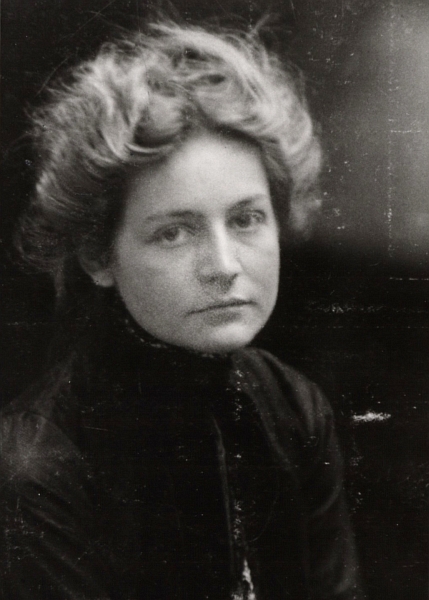
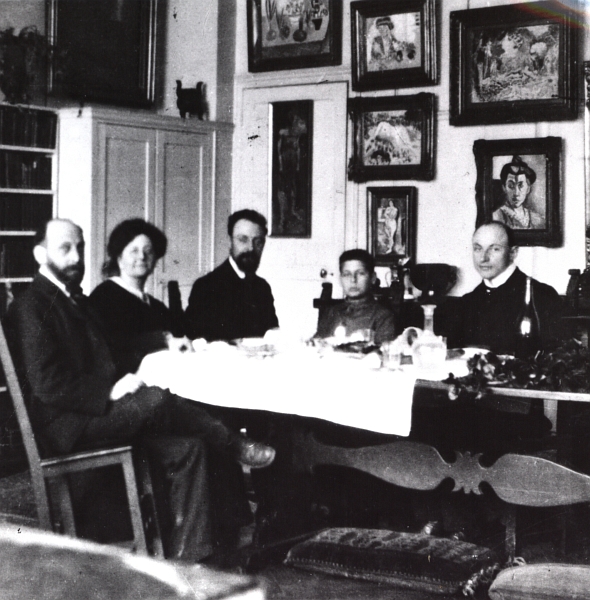
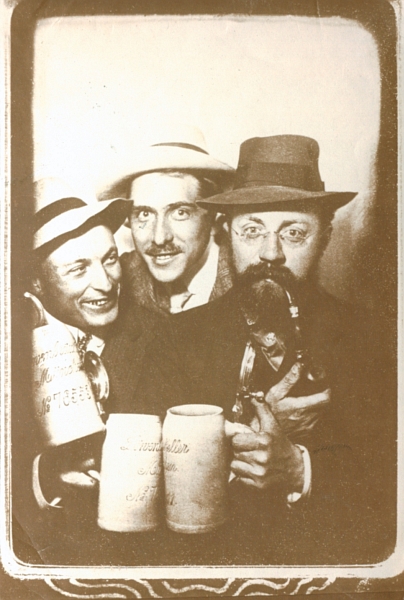
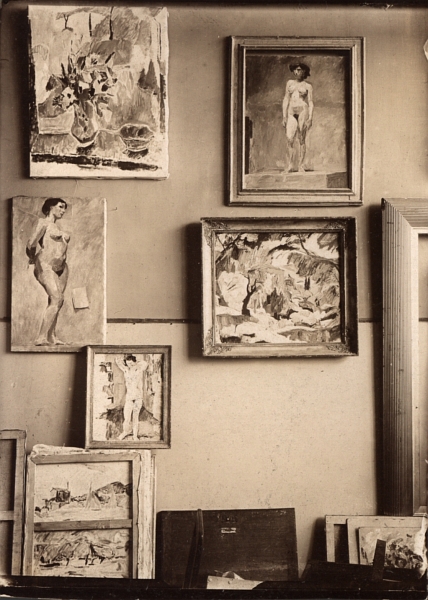
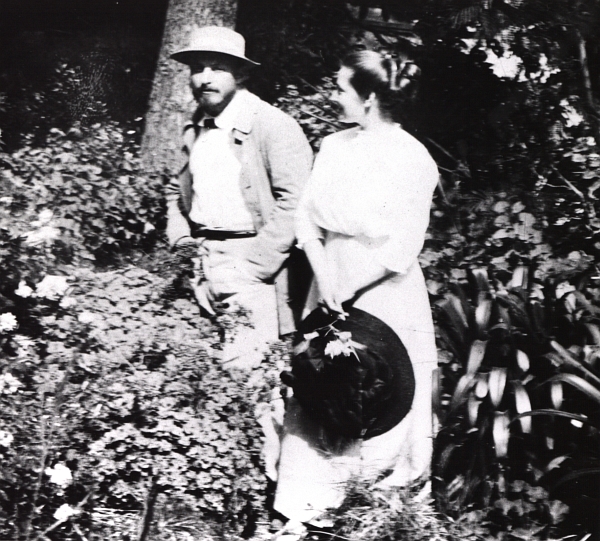
Beilstein 1914-1915
1914
The outbreak of war in July takes Purrmann by surprise in Beilstein. In Paris, he loses his studio, his apartment, and many paintings (including works by Renoir, Cézanne, Seurat, Picasso, Rousseau, and Matisse). In this period, he is often in Stuttgart, where he cultivates relationships with the painter Bernhard Pankok and the art dealer Zinser. Mathilde withdraws from painting to care for the children. Purrmann is called up for conscription at the end of December, but is released from military service in view of his disability. Purrmann suffers from Thomsen’s disease, a rare congenital nerve disorder that limits his freedom of movement and reaction speed. It causes him periodic falls and minor injuries. Purrmann begins to commit greater energies to graphic art, in particular drypoint, and continues to do so into the nineteen-twenties. He draws landscapes, nudes, and portraits, some of which were oriented to paintings and works of Matisse created at the same time. He is mentioned as a representative example in Wilhelm Hausenstein’s book “Die bildende Kunst der Gegenwart” (Munich, 1914).
1915
Purrmann continues to reside in Beilstein. In May, Weisgerber falls at Ypres, and his death grieves Purrmann deeply. Purrmann is deeply troubled, though he seeks to remain objective: “We Germans are ourselves not free from blame ...” (Roland 1996, p. 212). In Stuttgart, he discovers and acquires the painting “Venus at Her Toilet” by Johann Liss, a painter of the German Baroque. Purrmann spends the summer in Munich, where he copies the “Massacre of the Innocents” by Peter Paul Rubens in the Alte Pinakothek. He meets with the art historian Heinz Braune (1880–1957) and makes an etching of him, as well as a portrait of Braune’s wife. Braune is later to become not only a museum director in Breslau and Stuttgart, but also, quite early in his career, one of the most significant of Purrmann’s collectors. Purrmann participates almost every year from 1915 on in the exhibitions of the Free Secession in Berlin, at times participating in the exhibitions of the Berlin Secession as well. In September of 1915, he begins looking for an apartment and studio in Berlin.

Berlin | Langenargen | Italy 1916-1935
1916
In late January, Purrmann moves to Berlin where he resides at Franzensbaderstr. 3 in the neighborhood of Berlin-Grunewald until 1923 (see Dresslers Kunsthandbuch 1921, p. 462). His studio is in Berlin-Schmargendorf, Marienbaderstr. 1. He writes to his brother of his extraordinary success, relating that even museums were buying paintings from him. Alongside his painter friends Rudolf Levy, Rudolf Grossmann, Konrad von Kardorff, and Max Slevogt, he is a regular at the Romanisches Café; another café guest was Karl Scheffler, the art historian and editor of the important journal “Kunst und Künstler”. Purrmann is in lively correspondence with Scheffler from the early nineteen-twenties on (twenty-four of Purrmann’s letters are in the archives of the Academy of Arts in Berlin). He comes to know the writer Johannes Guthmann, who acquires many of his paintings. Purrmann visits with Heinz Braune again in Glonn (in the southeast of Munich) and paints a second portrait of Braune’s wife Mary. After lengthy medical treatment in Heidelberg, Purrmann’s mother Elisabeth dies in Speyer in April. On September 16, 1916, his daughter Regina (1916–1997) is born. During this period, Purrmann also spends time in Nenndorf, near Hanover.
1917
Max Raphael publishes an “art letter” to Purrmann, discussing two studio interiors of the artist that he had seen in an exhibition in Zurich.
1918
Purrmann’s first major solo exhibition takes place before the end of World War I, in the spaces of Paul Cassirer’s Berlin gallery. An illustrated catalogue is published for the exhibition. For the occasion of the show, Curt Glaser writes the first major essay on Purrmann, which appears in “Kunst und Künstler”. Along with Glaser, Purrmann visits Erna Schilling, the companion of Ernst Ludwig Kirchner, and views the latter’s studio in Berlin.
1919
At the suggestion of Liebermann and Slevogt, Purrmann is named member to the Prussian Academy of Arts in Berlin, as well as a member of the acquisitions committee of the National Gallery. The event is announced with a photograph in the “Weltspiegel” of April 6, 1919. The Berlin Academy offers Purrmann a professorship, but he declines; he receives the title of professor in this period from a Bavarian academic institution (a fact related by Dr. Adolf Leisen, Speyer). On October 21, Purrmann signs a contract to acquire a fisherman’s house in Langenargen, on the shores of Lake Constance, in which he would live and work regularly from then until 1935. He had previously also considered a summer residence in the Palatinate and in the vicinity of Würzburg. The house is sold after Mathilde’s death in 1943. The ongoing contact between Purrmann and the art critic Wilhelm Uhde is documented by the many postcards from Uhde to Purrmann. In a piece for “Kunst und Künstler”, Purrmann congratulates Hans Thoma on the occasion of his eightieth birthday, Purrmann’s first documented publication. Together with Curt Glaser, Purrmann offers suggestions for improving Berlin exhibitions.
1920
The studio in Langenargen is fully furnished. Together with Heinz Braune and Paul Cassirer, he takes part in a trip to Rome in June. From August to September, Mathilde travels to Paris "on business" (Mathilde's passport, Hans Purrman Archive). Around this time, an auction of Purrmann's possessions left behind in Paris (flat and studio with furniture and works of art) takes place at the Hotel Drôuot in Paris. Mathilde is presumably present at these auctions, where an incident occurs and she is briefly taken into custody.
1921
Obviously, Purrmann did not leave his entire art collection behind in Paris or was even able to reacquire art possessions. Paul Cassirer thanked Purrmann in writing at the end of 1921 for the loans for his Cézanne exhibition. Purrmann is discussed in detail in Scheffler's book 'Talente' (Berlin 1921), to which Scheffler adds an account entitled 'Hans Purrmann und der moderne Kolorismus' in 'Kunst und Künstler'.
1922
In the summer months, Purrmann travels with his family to Sorrento on the Gulf of Naples. Rudolf Grossmann, who accompanies them, make a series of drawings that are later included as illustrations to Annette Kolb’s 1925 story “Veder Napoli e partire”. The artist is mentioned in Glaser’s definitive book „Die Graphik der Neuzeit“ (Berlin, 1922). Purrmann continues his output as an author, publishing three essays, one entitled “Aus der Werkstatt Henri Matisses,” (From Henri Matisse’s workshop) another “Formlose Notizen über Graphik,” (Formless notes about graphics) and a third observing the death of Reinhard Lepsius. He also furnishes an introduction for the catalogue of his friend Rudolf Levy, and, in the pages of “Kunstblatt”, responds to the question Ein neuer Naturalismus? (A new naturalism?)
1923
Purrmann moves his main residence to Rome, where he remains until 1927. His children go to school there. In the spring of 1923, the year of hyperinflation, he is in Rome and Sorrento. He makes paintings of the Mediterranean coast, using the so-called Villa Gorki as a subject. He makes his first paintings of the Roman Forum. Joined by Hermann Ebers, he begins copying paintings in the Galleria Borghese, including a work by Titian.
1924
In June and July, he journeys to Sorrento, taking detours to Naples. Scheffler’s 1930 book “Künstleranekdoten” relates that Purrmann went to Ischia for the first time in this year, along with his fellow painters Kardorff and Hans Spiegel. Purrmann takes time on Ischia to work on his printed graphic art (see Heilmann, pp. 89–90), and is believed to have met with Matisse in September.
1925
Purrmann has a solo show in Basel at the Galerie Pro Arte. The opening speech is given by Purrmann’s friend Friedrich Rintelen (1881–1926), professor of art history in Basel, of whom the painter had made a portrait during his years in Munich.
1926
Purrmann spends the spring of 1926 in Munich and Venice. In July and September, he returns to Langenargen, where he paints the interior of the Church of St. Martin. In October, he goes to Paris, where he visits with the collectors Sarah and Leopold Stein as well as Matisse’s wife.
1927
Purrmann is back in Rome in the spring of 1927. On June 16, Purrmann is in Langenargen, and writes his fellow painter Wohlgemuth: “... yesterday I returned from Rome. For the past five years, I have spent my winters in Italy and only the summers here on Lake Constance. In Berlin I still have my studio and apartment (but rented), and have not been there at all the entire time! Yet, this winter I will be in Berlin again; Italy has become too expensive for me, and, after all, people have to see me back in Berlin again.” A major solo show is mounted in Kaiserslautern (fig. 10). Purrmann writes his first autobiographical notes, entitled “Aus meinem Leben,” for the catalogue.
1928
Purrmann is given his own show in Nuremberg, comprised of twenty-one of his works, within the context of the exhibition “Pfälzer Kunst von Churfürst Carl Theodor bis zur Gegenwart”. By then he had moved to Lützowufer 13 in Berlin, an apartment above Alfred Flechtheim’s gallery. Purrmann publishes “Van Gogh und wir. Die gefälschte Kunst. Expertisen–Restaurierungen–Fälschungen,” as well as “Über deutsche Malerei und ihre internationale Bewertung.”
1929
A newspaper article on Curt Glaser contains a photograph of Glaser’s circle in which Purrmann appears next to Karl Scheffler. One of Purrmann’s still lifes hangs next to paintings by Edvard Munch. Purrmann submits twenty-eight watercolors as his competition entry for the design of the Chapel of St. Roch in Hohenecken, near Kaiserslautern, the main memorial in the Palatinate to the fallen soldiers of World War I. His entry is not selected. His stay in Hendaye, near Bayonne is cut short by an acute case of typhus, one from which he and his wife would continue to suffer for years. In a contribution in “Kunst und Künstler”, Purrmann conveys his best wishes to Max Slevogt, who had turned sixty. He also contributes a discussion of Flechtheim’s Berlin exhibition of works by André Derain and expresses views critical of a lecture by Scheffler in a contribution in the journal “Kunstauktion”.
1930
In April, the press honors Purrmann on the occassion of his fiftieth birthday, and he receives the Ehrenpreis des Reichsministeriums des Inneren (Special Prize of the Reichs Interior Ministry). For the occasion, Curt Glaser writes on April 15, “Had Purrmann’s art been better understood, German painting would have been spared a number of false starts. Let us desire that this fifty-year-old artist, now in the full blossom of his artistic powers, at last, enjoys the broad influence and recognition that his works deserve ...”. Purrmann enjoys a tremendously productive summer stay at Sanary-sur-Mer, together with his colleague Heinrich Brüne, who lives in Wessling, near Munich. He also makes a number of new acquaintances, including Werner Gilles. Purrmann writes a foreword for the Matisse exhibition at Flechtheim’s gallery in Berlin. Observations of Purrmann’s are published under the title “Malereien der Kinder.”
1931
Purrmann travels to Paris, meets with Matisse, and goes to exhibitions, including one of Picasso’s. He spends time in Venice, where he paints watercolors exclusively. In May, he learns that he has been commissioned to design the front of the meeting hall in the Rathaus of Speyer. After an extended exploratory process that can be traced through a series of watercolors, he settles on executing an Allegory of Art and Science in the form of a triptych. Writing in “Kunst und Künstler” on the occasion of the 1931 Academy exhibition, Karl Scheffler makes express reference to Purrmann’s work in Sanary-sur-Mer.
1932
Purrmann carries out an initial full-size cartoon of the triptych (held by the Landesmuseum Mainz). He tests the on-site effect by hanging the cartoons at the Rathaus and taking photographs from a variety of angles. The canvases, which Purrmann completes around mid-year, are first introduced to a wider public in July at the Academy of Arts in Berlin. Shortly before their permanent installation in the Rathaus in December, a defamatory debate took place in Speyer as to whether the paintings should be put up at all. In „Kunst und Künstler“, Purrmann discusses Slevogt’s frescoes in Ludwigshafen. He also congratulates the publisher Bruno Cassirer with an essay in the Festschrift that appears to celebrate Cassirer’s sixtieth birthday.
1933
In May, Purrmann spends three weeks taking the waters in Karlsbad. On May 18, 1933, he writes Brüne from there: “I have now spent a long time in Berlin and have moved to Genthiner Strasse 13 Berlin W 35, it saves me a great deal on rent and makes it easier for me to travel again! I have been working a great deal, exhibiting a great deal. Again and again, the paintings come back unsold. For two years now, I have sold nothing but a few watercolors. One can very nearly despair when one’s profession does nothing but bring in expenses and no income at all.” Purrmann is among the artists against whom a National Socialist-indoctrinated campaign was directed. It weighs on him heavily: “I had the greatest difficulties in Speyer; they wanted to [illegible] my paintings and now they are nailed shut with swastika flags hung over them; at least they are safe for the time being, not more than two or three people intervened on my behalf and the Kampfbund and the Notgemeinschaft Pfälzer Künstler [the “Battle League” and the “Emergency Action Organization of Artists of the Palatinate,” two National Socialist-linked organizations–trans.] have sent around circulars saying that the past era must be swept away and that reactionary liberal paintings must be eliminated and this letter, which got forty-nine to fifty positive responses, was signed by that whore swine [Hurenschwein], the painter Fay, who also painted a painting in the Rathaus, and what is sadder yet is that the painter Haueisen is with them too. A large Palatinate exhibition is going on in Berlin now and I was not invited at all!” (Letter to Brüne, December 22, 1933) An exhibition of the Swiss painter Alfred Heinrich Pellegrini is organized at the Kunsthalle in Basel, and Purrmann is able to participate. He is not mentioned on the catalogue cover. Purrmann’s last publication for some years is dedicated to the art of the South Seas. He gives shelter to the artist Thomas Theodor Heine, who was sought by the Nazis, and assists him in getting out of Germany into Czechoslovakia. Captions on the back of photographs of subjects for watercolors as well as the acqusition date of the Graphic Collection of the Staatsgalerie Stuttgart (W 1933/04) demonstrate that Purrmann did not travel to Trento for the first time in 1939, but had already been in 1933.
1934
Purrmann spends the beginning of the year in Florence. In February he travels to Breslau and Schreiberhau (both in Silesia), where Johannes Guthmann lives. In September, Purrmann, along with his painter colleagues Hugo Troendle and Rudolf Hoerschelmann from Munich, travel together to the Corot exhibition in Zurich. In November, Purrmann takes his last trip to Paris before the war, where he meets Matisse again. In 1933 and 1934, Purrmann gives a number of paintings to Dr. Lucas Lichtenhan, director of the Kunsthalle in Basel, for sale on commission, thus hoping for income from the sale of his works.
1935
The burial of Max Liebermann is on February 11. Purrmann is among the mourners present. A painting by Purrmann is removed from the exhibition Berliner Kunst in München in the Neue Pinakothek in Munich.
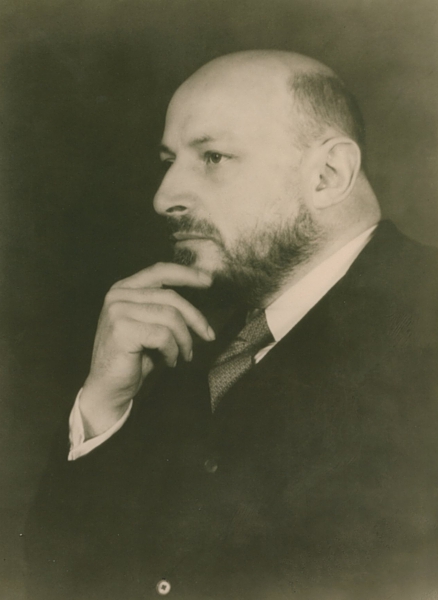
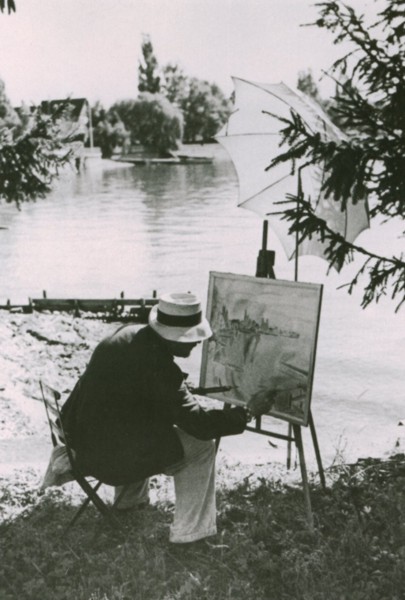
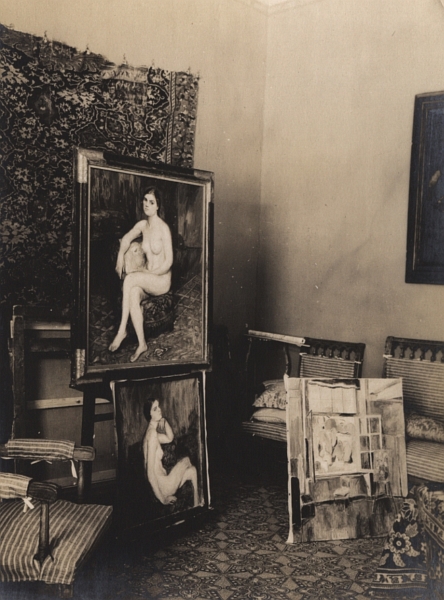
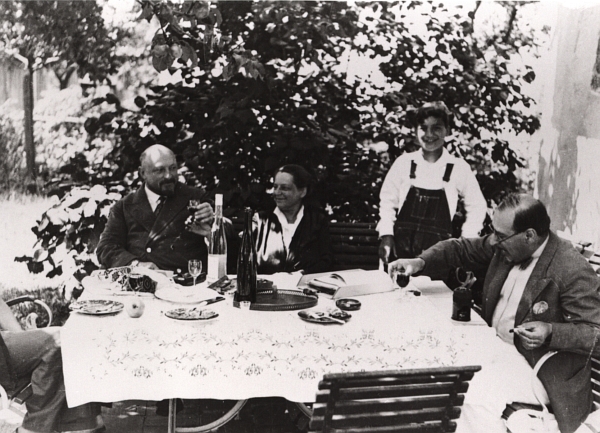
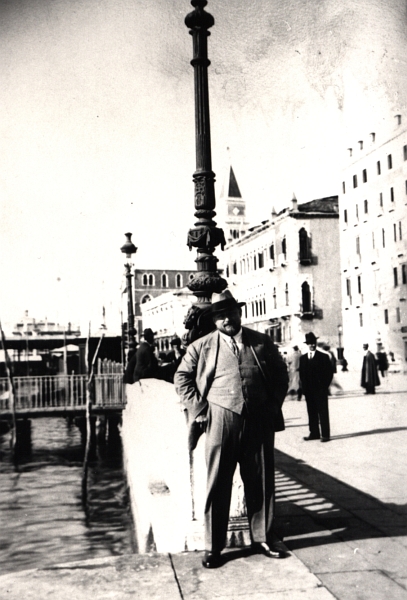
Florence 1935-1943
1935
In October, Purrmann moves to Italy, assuming the administration of the Villa Romana in Florence, a foundation for German artists. The selection of Purrmann is a surprising one, since among the thirteen candidates are multiple National Socialists; what is more, the Ministry of Propaganda suggested a candidate of its own, the archaeologist Baron von Bissing. The chairman of the Villa Romana foundation is Hans-Alfons Simon, director of the Berliner Bank. The Villa Romana foundation, created in 1904 by Max Klinger and others, was established to help young German artists to spend a year in Florence. Purrmann would play a major role in the recreation of the Villa Romana foundation in 1958. He maintains manifold contacts not only to the scholarship recipients but also to members of other German institutions, such as Dr. Hugo Max, director of the German School, which ultimately came to own a large collection of Purrmann’s paintings. He also has contacts at the Kunsthistorisches Institut, the German art historical institute in Florence; in September 1943, Purrmann would witness the tragic death of its director, Friedrich Kriegbaum, in a bombing raid. Other important contact persons are the art historians Herbert Siebenhüner and Theodor Hetzer. Siebenhüner and Purrmann share interests in the history of color in art. Purrmann related to Hetzer’s widow the influence that Hetzer and Hetzer’s writings had on him: “I know of no art historian who thought so independently, and who was so full of original ideas, as your husband. I turn to his books again and again, for they really immerse me in the artists. What I found particularly and tremendously pleasing was what he thought and said on surface in painting. I have found no remarks on composition as excellent as those in his book on the majesty of Dürer’s paintings, a book to which I often return.” (Göpel 1961, p. 265).
1936
Negotiations in the early months of the year regarding renovations of and additions to the Villa Romana: Purrmann instructs the conversion of the dilapidated orangery “Limonaia” into two garden studios, which will be badly damaged in the war. Purrmann writes to Brüne in January that he intends to exhibit at the Galerie Nierendorf in Berlin. He spends the summer months on the Ligurian coast in Monterosso and Lerici, painting a substantial number of watercolors.
1937
Purrmann is in Stuttgart for Christmas of 1936 and into 1937. Illness compels him to set aside his plans to travel to Munich. In the summer of 1937, he makes a study visit to Castiglioncello, where he focuses on watercolors. Purrmann is officially deemed a “degenerate artist.” Thirty-six of his paintings and a larger number of graphic works are removed from public museums in Bremen, Munich, Kaiserslautern, Karls-ruhe, Cologne, Stettin, Breslau, and other cities, works that for the most part have yet to be located. Two of Purrmann’s paintings are included in the touring exhibition “Entartete Kunst”. The exhibition of his works is forbidden. These circumstances complicate his position in Florence. He is falsely accused of having been a member of the “Novembergruppe,” a group of revolutionary artists in 1919 and afterwards. To his great surprise, Purrmann is mentioned in Bruno Kroll’s book „Deutsche Künstler der Gegenwart“.
1938
Hitler and Mussolini meet in Florence on May 9. Purrmann is taken into protective custody for some time, and is placed in the “Murate” prison. Purrmann is visited in this period by Theodor Heuss, the future Federal President of West Germany, whom he knows from his time in Paris. In Siena, Purrmann runs into the painter Leo von König and his family. The artists grow closer and paint together in the Sienese countryside. In the same year, Purrmann paints in Lerici (near Genoa), and in Val Gardena in South Tyrol.
1939
In the spring of 1939, the board of the Villa Romana votes unanimously for Purrmann’s dismissal. After Purrmann proves that he was never involved in the Novembergruppe actions, the dismissal, which was to have been reassessed at the end of the year, is withdrawn. Hans Alfons Simon, the chairman of the foundation, had threatened he would have resigned if Purrmann were fired. In the summer, Purrmann travels to Trento, where he paints only a small number of oils, but a large number of watercolors. After the outbreak of war, Purrmann’s circle at the Villa Romana becomes a meeting place for exiles, including Kasimir Edschmid, Curt Glaser, Werner Haftmann, Monica Mann, and Leopold Stein.
1940/41
Purrmann spends February of 1940 in Munich. Herbert Siebenhüner and Edmund Hausen publish appreciations of his work in the German press on the occasion of his sixtieth birthday. The board of the Villa Romana honors Purrmann with a certificate. Furthermore, the Kunsthalle in Bern organizes a common exhibition and sale for Purrmann, Fred Stauffer, and Erich Wendelstein in August and September. A total of fifty-eight paintings, some privately held in Basel, are brought together. During the summer months, Purrmann is at the seaside resort of Fano on the Adriatic. He writes to Brüne: “... it is not particularly interesting here, but it is the only stretch of coast that is not all too much a war zone and where one can receive (as I have myself received) permission to paint! I will not stay long, and will return soon to Florence ...”. Purrmann requests an identification card from the Italian authorities on which, under nationality, is written “Italiana.”
1942
Purrmann takes part in multiple exhibitions, including “Kunstschaffen der Westmark” in Saarbrücken (review in the Frankfurter Zeitung, July, 1942). Dr. Franz Fleischmann, as head of the Kunstverein in Grünstadt, plays a major role in the exhibition. Purrmann’s brother Heinrich brings the artist’s works to the exhibition sites. Purrmann visits his son in Munich.
1943
One of Purrmann’s few exhibitions takes place in March and April at the ‘II Fiore’ gallery in Florence. Piero Santi gives the opening address. Arturo Rosai paints a portrait of Purrmann. In May, the threats of war prompt Purrmann, Levy, and Kriegbaum to retreat to Saltino Vallombrosa, near Florence. On July 16, Purrmann’s wife Mathilde dies in Munich after a long illness; she is buried in Langenargen. Purrmann’s brother Heinrich dies in Speyer. The Berlin apartment is destroyed in an Allied bombing raid. Purrmann travels to Berlin, Mittel-Schreiberhau, Dresden, and Stuttgart. After the fall of Mussolini on July 25, the German residents of Florence are instructed to leave Italy. On November 9, Purrmann writes to Karl Scheffler from Switzerland: “I stayed in Florence even after all the Germans had departed on the last train. I saw much, though nothing happened to me personally.”

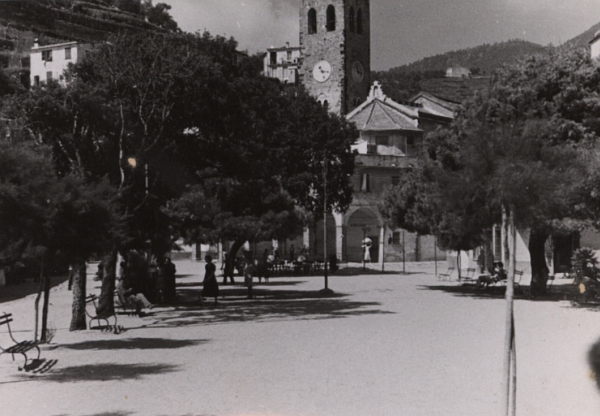
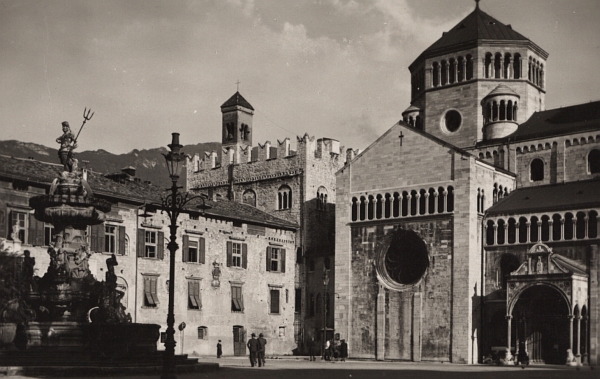

Montagnola 1943-1966
1943
In early October, Purrmann receives a visa from the Swiss consulate and is able to flee to Switzerland, going first to his wife’s family in Zurich. He is forced to leave all of his belongings behind in Florence, including his own paintings and his valuable art collection. In Zurich in October, he writes to Hilde Wolf explaining his plans to move to Ticino, to Castagnola, near Lugano: “... I would like, if possible, to move to Ticino. It is best suited for my work, and I must think of my work, for I have been thrust away from it for so long.” In Castagnola, he spends the winter at the Hotel Boldt. A deposit payment made by Purrmann’s nephew Hans Vollmoeller makes possible his stay in Switzerland, though not without restrictions (he is not permitted to sell paintings or take part in exhibitions).
1944
Purrmann moves to Montagnola on the Collina d’Oro, above Lugano, and resides initially at the Hotel Bellevue; it is run by Signora Ceccarelli, and remains in her family to this day. Purrmann paints portraits of her daughter Gabriella as a small child and later as an adolescent. From Montagnola, Purrmann writes to Brüne on October 8, 1944: “I am a little bit hidden away and very secluded in my life here. My relatives are in Zurich. I could visit them, live with them, but a great timidity holds me back. I fear being drawn into political discussions and the ever-ubiquitous amicability toward Germans annoys me to no end!”
1945
When the war ends in May, Purrmann is in Montagnola. It is around this period that Purrmann cultivates a friendship with the textile artist Maria Geroe-Tobler (“Mareili,” 1895–1963), from St. Gallen. She studied under Paul Klee and Wassily Kandinsky at the Bauhaus in Dessau, and is also on friendly terms with Hermann Hesse. Marino Marini paints a portrait of Purrmann. Purrmann becomes friends with Hesse, also residing in Montagnola, and with the Swiss patron of the arts and collector of African art Hans Coray, who lives in Agnuzzo. In July and August, Purrmann displays ten paintings at the exhibition „Ausländische Maler in der Schweiz“, which is organized by the Bern Kunsthalle.
1946
Early in the year, Purrmann travels to Basel, Zurich, and Konstanz, where he is reunited with his son Robert and his daughter-in-law Mechtild, daughter of the painter Leo von König. In November, he is visited by Fritz Volbach, who attempts in vain to persuade Purrmann to return to Germany. The artist resumes his efforts as an author. A further article on Matisse appears in the journal Werk.
1947
Important recollections of Purrmann’s, entitled “Erinnerungen an meine Studienzeit,” are published, again in Werk.
1948
Purrmann finally receives a work permit from the Swiss authorities. He moves into the Casa Camuzzi, previously occupied by Hermann Hesse. Over and over again, into the early nineteen-fifties, Purrmann will paint the view from the Casa Camuzzi onto the garden terrace and Lake Lugano. During this period, Purrmann also rents a studio some distance below the Hotel Bellevue: “The tiny little house, sitting all alone above a goat shed in the verdure, was reached by a narrow footpath that wended its way through high meadows, with a marvelous view down into the valley and the town of Agno ...” (Heidi Vollmoeller, 1982). Purrmann is a neighbor of the painter Gunter Böhmer, who had resided at the Casa Camuzzi from 1933 on. Böhmer’s diary „Purrmanniana“ allows a look into the lively personal exchange between the two artists in the years between 1957 and 1961. Later, the painter Georg Meistermann would also live at the Casa Camuzzi. Purrmann reestablishes contact with Elisabeth Heintz, whom he knew from Florence. As Purrmann’s secretary, Heintz assists the artist in the years to come with the administration of his extensive correspondence. In October, Purrmann is able to spend a number of days in Florence.
1949
The idea for a major Purrmann exhibition in Switzerland is largely realized by his Zurich-based niece Heidi Vollmoeller (1916–2004). In September, the two travel together to San Remo and nearby Ospedaletti, where Purrmann paints many watercolors. His niece recalled in 1994, “In 1949, the Museum of Art Lucerne put on a wonderful exhibition of the paintings of Henri Matisse. ... Inspired by this exhibition, I undertook in secret, without the knowledge of my uncle, to interest a number of Swiss museums in the possibility of organizing a Hans Purrmann exhibition. The Museum of Art Lucerne expressed interest on the condition that Purrmann’s paintings would be displayed together with works by the German painter Richard Seewald. Hans Purrmann gave his consent to the condition.” In April and May, Purrmann contributed five paintings to the exhibition Kunst in Deutschland 1930–1949 at the Kunsthaus Zürich. Purrmann is named an honorary member of the Hochschule der bildenden Künste in Munich. The text “Die Einheit des Kunstwerks” (The unity of the work of art) is published in the journal Werk.
1950
For the first time after the war, Purrmann travels to Germany, to Lake Constance. He is also reunited with Karl Scheffler in Überlingen. On the occasion of his seventieth birthday in April, he is named an honorary citizen of the city of Speyer, an award he will not accept in person until the following year. He is ill in May and stays at the clinic of St. Anna in Sorengo (Lugano). Purrmann spends August through October in Capo di Sorrento. Purrmann exhibits a total of sixty-four paintings, twenty-seven watercolors, and twenty-six drawings at the Museum of Art Lucerne. The catalogue foreword is from the pen of Heinz Braune. A still larger touring exhibition, including seventy-nine paintings, begins as a solo show at the Pfalzgalerie Kaiserslautern, progressing onward to Speyer, Mannheim, Stuttgart, Munich, Hamburg, Bremen, and Bochum. Released at the same time is the first monograph on Purrmann, Der Maler Hans Purrmann. The author is Edmund Hausen, former director of the Museum of Arts and Crafts in Kaiserslautern. Karl Scheffler had been the first choice of authors, but he declined on the grounds of his age. Purrmann attends the Venice Biennale, where he views works of Max Beckmann, a few months before Beckmann’s death, and the Triennale in Milan. Purrmann is a member of the jury of the Deutscher Künst¬lerbund (Association of German Artists), which exhibits annually in different cities. He finds the traveling and the work on the juries to be increasingly wearisome, although it allows him to deepen friendships with other artists, such as Ernst Schumacher. He prepares the text “Wandel ist der Künste Weg,” (Change is art’s destiny) although it will not appear in print until published by Göpel in 1961.
1951
At the invitation of Matisse, Purrmann travels with Heidi Vollmoeller to Nice and Vence to attend the dedication of the chapel the interior of which Matisse has painted. In the summer, he continues on to Sorrento, a city Purrmann had first visited in the nineteen-twenties. In late fall, Federal President Heuss pays an unofficial visit to Purrmann in Montagnola. Purrmann becomes a Corresponding Member of the Bavarian Academy of Fine Arts. Emy Roeder creates a bronze bust of Purrmann. Purrmann authors his views on the matter of Kunst ohne Publikum (Art without Audience, published in 1953 and 1955), relating his experiences as a defamed artist in the nineteen-thirties.
1952
Another summer in Sorrento. Exhibition and sale of works at the Aargauischer Kunstverein at the Aarau Museum of Arts and Crafts, with a total of seventy-nine works. He is together with his son Robert in Zurich. Purrmann exhibits successfully within the context of the “New Group” in the Grosse Kunstausstellung München almost until the time of his death. Purrmann is a member of the jury of the Deutscher Künstlerbund in Cologne.
1953
First return trip to Ischia to paint. Purrmann stays at the same albergo in Porto d’Ischia, looking out over the harbor, as he had in 1924. On Ischia, he encounters such artist friends as Hans Kuhn, Werner Gilles, Eduard Bargheer, and Ernst Schumacher. In Montagnola, he paints a series of self-portraits. To one of these paintings, Hermann Hesse dedicates the poem “Alter Maler in der Werkstatt” (Old painter in his workshop). At the Palazzo Reale in Milan, Purrmann views the Picasso exhibit, which makes an immense impression on him. At an unknown juncture in 1953, he spends fourteen days in Paris. He spends Christmas in Beilstein.
1954
The death of Matisse affects Purrmann deeply. Early in the year, he travels to Florence; in March he is a member of the jury of the Deutscher Künstlerbund in Frankfurt am Main. From there, he travels to Stuttgart and Munich. November in Zurich and in Freiburg where he undergoes medical treatment.
1955
Takes part in the first Documenta in Kassel. Purrmann travels to Palermo to paint on Sicily, but then chooses to go back to Ischia. Barbara and Erhard Göpel are his guests. Purrmann’s health is once again problematic, as he relates to Hesse in November: “But unfortunately I have been, and remain, in the worst conceivable health, and am, thus, in such a bad state that I am no longer able to contend with the business of life, am ceaselessly depressed and unhappy. What is more I am very nearly afraid of people ... ”. Purrmann is awarded the “Berlin Art Prize for Painting in 1955” with half the usual prize money attached. He refuses to accept. Der Spiegel reports on the matter on April 27: “That the prize amount for painting was cut in half .... must inevitably create a public impression of a ‘devaluation of his art.’” Purrmann is awarded the Great Cross of Merit of the Federal Republic of Germany; he is also named a Knight of the Civil Class of the Order Pour le Mérite for Science and the Arts. Purrmann is a member of the jury of the Deutscher Künstlerbund in Hanover.
1956
In Basel, he views the Beckmann exhibition, in Zurich an exhibition of Cézanne. A portrait sculpture of him is made by Gerhard Marcks. Purrmann is a member of the jury of the Deutscher Künstlerbund in Düsseldorf, where he focuses on Tachisme. He spends an extended period in Lacco Ameno on Ischia, where he paints numerous landscapes. Purrmann writes a memorial to the painter Rolf Müller-Landau, who founded the Palatinate Secession.
1957
Karl Schmidt-Rottluff, who lives in Ascona near Locarno, visits Purrmann in Montagnola, much to the latter’s pleasure. Purrmann travels extensively through Germany. He is a member of the jury of the Deutscher Künstlerbund in Berlin, goes to museums in Frankfurt am Main and Wiesbaden, and in Mainz is awarded (along with Carl Zuckmayer) the Art Prize of the Rhineland-Palatinate. Afterwards, he goes to Munich to be a jury member for the Grosse Kunstausstellung. Summer in Porto d’Ischia.
1958
In the spring, Purrmann travels to Greece (Athens, Delphi, Olympus) with his son Robert, his daughter-in-law Mechtild, and Heidi Vollmoeller. The trip impresses him greatly, but does not prompt him to paint. After Greece comes a last summer stay on Ischia. Visit to a Modigliani exhibition in Milan and the twenty-ninth Biennale in Venice. Purrmann also goes to the Villa Massimo in Rome. The Pfälzische Landesgewerbeanstalt Kaiserslautern mounts the exhibition „Hans Purrmann. Werke der letzten Jahre“. Purrmann is represented by a number of paintings at the major retrospective München 1869–1958: Aufbruch zur Modernen Kunst, held at the Haus der Kunst. His „Denkschrift betreffend die Villa Romana und ihre Weiterführung“ is published.
1959
In early January, Purrmann paints a portrait of Barbara Göpel, whose vivid account of their sessions offer valuable insights into Purrmann’s creative process (see Göpel 1980). Together they watch a film in Lugano on Picasso, which fascinates Purrmann. After a tiring jury in Wiesbaden, Purrmann stays well into the summer at the Villa Massimo in Rome, where he becomes very ill; it is believed he suffers a stroke at this time. He is in the hospital until October, and relies on a walker and wheelchair thereafter.
1960
Purrmann’s eightieth birthday is the backdrop for his largest solo exhibition yet, including 168 paintings and numerous works of graphic art, held first at the Galerie Vömel in Düsseldorf, then at the Kunstverein Hannover. The studio immediately adjacent to the Casa Camuzzi, which has been planned for some time, is finished. It is designed to be accessible for Purrmann’s wheelchair. Many artists, collectors, and art historians call on him, and requests for his work as a portraitist also grow. The slender volume „Hans Purrmann: Landschaften und Stilleben“ appears with a retrospective foreword by the artist himself and an appraisal of his work by his friend, the author Kasimir Edschmid. Under the title, “‘Und lasst uns wieder von Cézanne reden.’ Bemerkungen zum Schaffen und Einfluss Cézannes,” the Cologne Deutsche Zeitung publishes an article that Purrmann wrote in 1958 and 1959 at the suggestion of Erhard and Barbara Göpel.
1961
Purrmann designs a large mosaic for the new theater in Speyer; the mosaic, however, is not executed. From August through October, he is in the hospital in Milan. Erhard and Barbara Göpel’s volume on Purrmann’s life, still authoritative today, is published: „Leben und Meinungen des Malers Hans Purrmann anhand seiner Erzählungen, Schriften und Briefe zusammengestellt“. Erhard Göpel also publishes Hans Purrmann. Sommer auf Ischia. The photographer and journalist Hans Kinkel takes powerful portrait photographs of the aged artist between 1961 and 1965, which appear in 1973 under the title Hans Purrmann in Montagnola. Purrmann receives the Stephan Lochner Medal of the city of Cologne. The Italian state names him a “Commendatore nell’Ordine al Merito della Repubblica Italiana.” The catalogue of the holdings of the Kohl-Weigand Collection, prepared by Hans-Jürgen Imiela and Wilhelm Weber, gives Purrmann his place alongside Slevogt and Weisgerber. In his article, “Im Gedenken an Werner Gilles,” Purrmann articulates his views on his deceased friend and colleague. He writes memorably in the Stuttgarter Zeitung, on “Das verlorene Menschenbild.”
1962
The retrospective of Purrmann’s paintings is shown as a touring exhibition in Munich (at the Haus der Kunst), then in Baden-Baden and lastly in Frankfurt am Main. The exhibition encompasses 128 paintings from all periods of the painter’s creative output, and is made possible through the assistance of the artist’s friend and colleague Ernst Schumacher. The opening address is given by the art historian Gotthard Jedlicka of the University of Zurich. Erhard Göpel organized the exhibition and prepared the catalogue. Purrmann reworks a series of past paintings for the show. An interview with Purrmann is filmed in the course of the exhibition. Purrmann receives the Bavarian Order of Merit from the prime minister president of Bavaria, an honor for which Erhard Göpel had strongly pressed. Purrmann receives the title of “Officier de l’Ordre des Arts et des Lettres de la Republique Française” from the French state. The summer is spent in Levanto, near La Spezia, on the Ligurian coast. His son finds the remote Villa “Le Lagore.” Here Purrmann’s art could once again emerge in paintings of park benches, fountains, and the villa’s chapel turned studio.
1963
An extensive touring exhibition of the complete graphic works travels to Kaiserslautern, Hagen, Ludwigshafen am Rhein, Baden-Baden, and Freiburg. The exhibition catalogue contains a catalogue of works for Purrmann’s graphic art, compiled by Wilhelm Weber, which served as the basis for the authoritative catalogue raisonné published by Angela Heilmann in 1981. Exceptionally bad weather makes the summer in Levanto an unproductive and depressing one for Purrmann.
1964
Another summer in Levanto. Purrmann feels lonely and is tormented by self-doubt. He is awarded the Great Cross of Merit with Star of the Federal Republic of Germany.
1965
The last summer in Levanto. Exhibition of portraits by Purrmann at the Pfalzgalerie Kaiserslautern, with assistance in compiling the works from the artist himself (handwritten lists of paintings in the Hans Purrmann Archiv). Wilhelm Weber gives the opening address; Purrmann contributes a piece to the catalogue, “Über das Porträt-Malen.” In the November 13 edition of the newspaper Rheinpfalz, he dedicates a “best-wishes address” to the chair of art history at Mainz, Prof. Dr. Gerke, on the latter’s sixty-fifth birthday. In December, Purrmann writes a foreword for the catalogue of his paintings owned by the collector Franz-Josef Kohl-Weigand. At fifty paintings, it is the largest private collection of the artist’s works (today held by the Saarland Museum, Saarbrücken).
1966
In the last months of his life, Purrmann continued to work on portraits of Effi Bantzer and Felix H. Man, the famed photojournalist. The exhibition of the Franz-Josef Kohl-Weigand collection „Hans Purrmann. Gemälde, Aquarelle, Handzeichnungen und Druckgraphik“ takes place at the Art Historical Institute of the Johannes Gutenberg University in Mainz from January through March. In the spring, Purrmann is confined to bed, then must be flown to the cantonal hospital in Basel for treatment of pneumonia. After a temporary improvement, Purrmann dies on April 17. His last words are: “Portami i colori!” (Bring me the paints!). On April 22, he was laid to rest in Langenargen, where he was buried next to his wife.

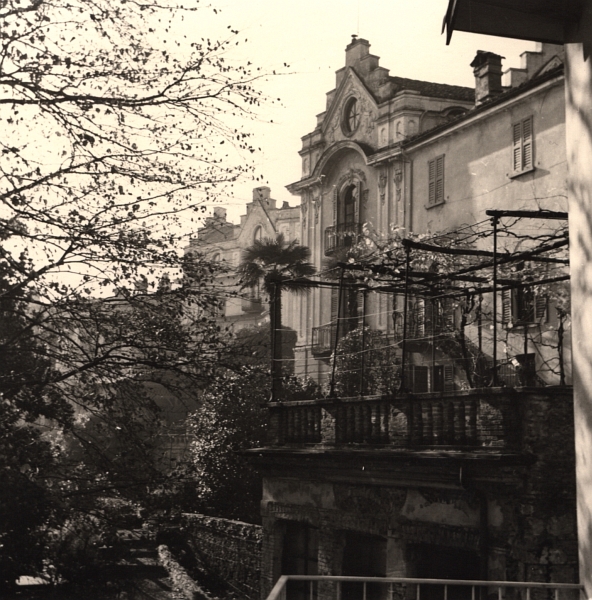
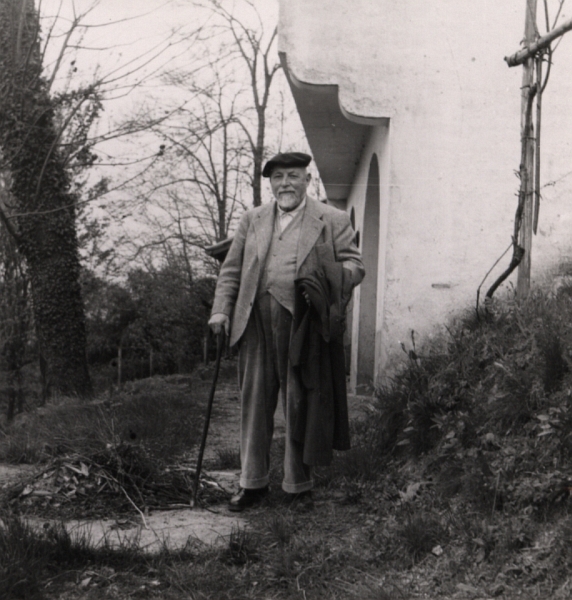
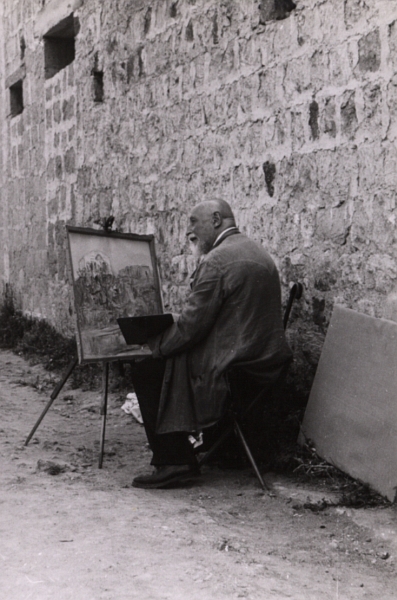
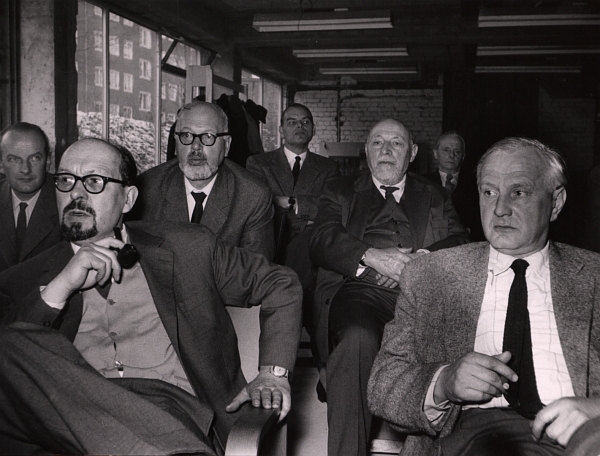
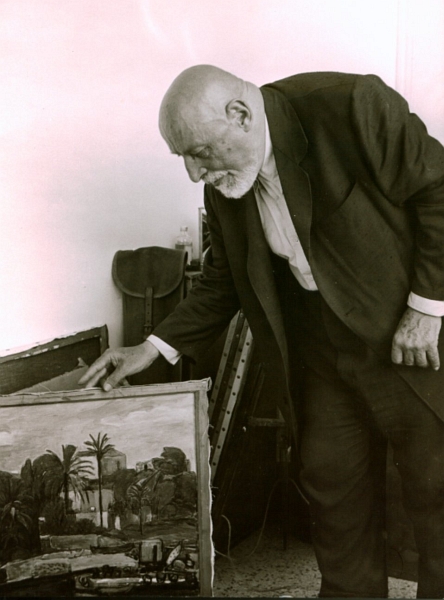
Address
Hans Purrmann Archiv
Schleißheimer Str. 9 | Rbdg.
80333 München
Contact
Phone: 089 – 54 24 35 70
Fax: 089 – 54 72 63 98
office@purrmann.com
